India has made progress in its efforts to develop a reusable launch vehicle (RLV)/rocket named 'Pushpak'. The country successfully tested the landing of RLV LEX-2 on Friday at the Aeronautical Test Range (ATR) in Karnataka's Chitradurga. According to the Indian Space Research Organisation (ISRO), the RLV LEX-2 demonstrated autonomous landing capability from off-nominal initial conditions after release from a helicopter.
The Indian space shuttle, named the winged Pushpak, was lifted by an Indian Air Force helicopter and released from an altitude of 4.5 km. After release, Pushpak traveled 4 km on its own and made cross-range corrections as it approached the runway.
Pushpak landed precisely on the runway and came to a halt using its brake parachute, landing gear brakes, and nose wheel steering system, according to ISRO. This marked the second successful test landing of ISRO's RLV.
“The mission successfully simulated the approach and high-speed landing conditions of RLV returning from space. With this second mission, ISRO has revalidated its indigenously developed technologies in the areas of navigation, control systems, landing gear, and deceleration systems essential for performing a high-speed autonomous landing of a space returning vehicle,” the Indian space agency said.
What is Reusable Launch Vehicle?
The concept of a reusable launch vehicle is to recover the highly expensive launch vehicle and reuse it for subsequent space flights. The launch vehicles are equipped with additional protection, such as heat shields, grid fins, and other flight control surfaces. They weigh more compared to their expendable counterparts due to the additional avionics and propellant. The shape of the launch vehicle is also modified to support the recovery process.
The Reusable Launch Vehicle – Technology Demonstrator (RLV-TD) is one of the most technologically challenging projects of ISRO. It aims to develop essential technologies for a fully reusable launch vehicle to make space access more affordable. The RLV-TD is designed like an aircraft and combines the complexities of both launch vehicles and aircraft.
This winged vehicle serves as a flying test bed to assess technologies such as hypersonic flight, autonomous landing, and powered cruise flight. In the future, it will be scaled up to become the first stage of India’s reusable two-stage orbital launch vehicle.
The RLV-TD consists of a fuselage (body), a nose cap, double delta wings, and twin vertical tails. It also features symmetrically placed active control surfaces called elevons and rudder. This technology demonstrator was boosted to Mach number 5 by a conventional solid booster (HS9) designed for a low burn rate. The selection of materials, such as special alloys, composites, and insulation materials for developing an RLV-TD, and the crafting of its parts, is very complex and demands highly skilled manpower. Many high-technology machinery and test equipment were utilized for building this vehicle.
ALSO READ: What is proposed Digital Competition Law and how does it impact digital enterprises? Explained

